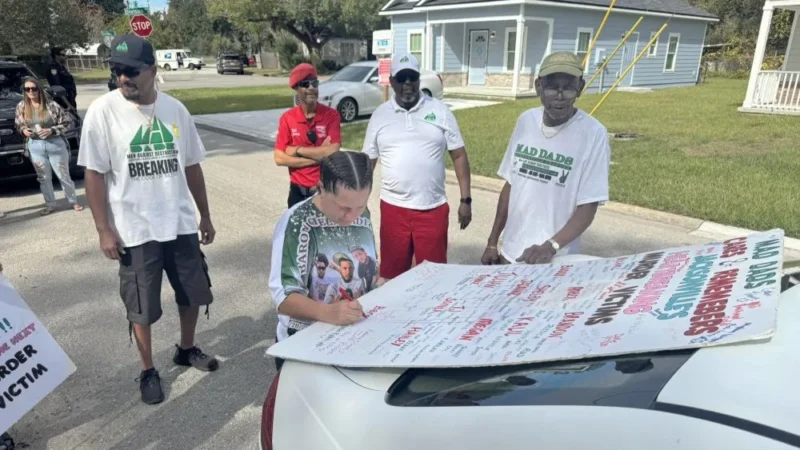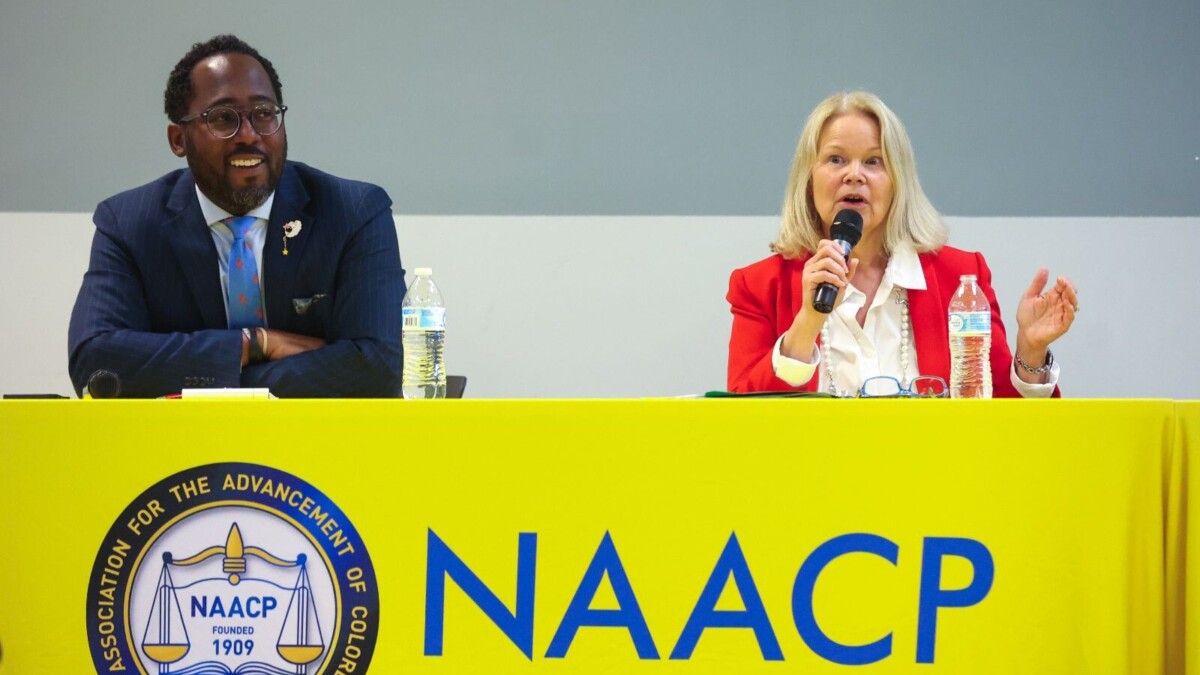Starting Wednesday, people have lost access to legal abortions in Florida beyond six weeks of pregnancy.
The restriction replaces a 15-week ban that’s been in effect since July 2022, shortly after the U.S. Supreme Court overturned Roe v. Wade.
Abortion rights supporters say it will dramatically curb access to the procedure for thousands of residents in Florida and around the Southeast. Proponents of the ban say it “protects life.”
Voters will have a say on the matter in November, when a proposal to enshrine abortion rights into the state constitution will appear on the election ballot. Regardless of what happens this fall, the ban going into effect this week could have far-reaching impact.
Here are seven things to know:
1. Abortion services are still available until six weeks gestation
Florida has not banned abortion entirely.
Opponents of the ban stress many women, transgender and nonbinary people don’t even realize they are pregnant at six weeks. But some do, most likely those with regular menstrual cycles who can access pregnancy tests.
Some reports indicate about 40% of abortions performed in Florida in recent years were for patients who hadn’t yet reached six weeks gestation. Gestational age is based on the date of your last menstrual period and confirmed with an ultrasound.
Abortion care providers in the state like Planned Parenthood have extended their hours to accommodate as many patients as they can.
“We want to be able to help everyone with information in order to access care as quickly as possible,” said Barbara Zdravecky, interim CEO of Planned Parenthood of Southwest and Central Florida.
Still, many patients will be too far along when they reach out for help, she expects.
“The emotional turmoil that’s going to happen, the anger, the fear, the anxiety is going to be great,” said Zdravecky, who added centers are ramping up support staff to respond to patients’ concerns and help them navigate their options.
Adding to the challenge are Florida’s 24-hour mandatory waiting period and ban on using telemedicine for abortions. Patients have to attend two in-person appointments, one for a consultation and another for the procedure at least one day later.
Eventually, some clinics may close if they can’t afford to keep operating with reduced abortion services. Independent clinics provide the majority of abortions in the U.S., but are also more vulnerable to closure, according to a report from Abortion Care Network.
You can find an abortion provider nearest you on this website.

2. There are exceptions to the six-week ban, but they have limits
Florida’s six-week abortion ban includes exceptions for some vulnerable communities and when a mother or fetus’ life is in danger.
Survivors of rape, incest or human trafficking can access abortions until 15 weeks of pregnancy under the new law. But it mandates they provide a copy of a restraining order, police report, medical record or other documentation to their appointment, and providers may be obligated to report the crime in some cases.
Many survivors don’t feel safe or comfortable reporting assaults, noted Stephanie Loraine Piñeiro, executive director of the abortion fund Florida Access Network. She called the requirements “unrealistic” and “incredibly cruel.”
As with the previous 15-week ban, there are exceptions to save the pregnant person’s life or avert “substantial and irreversible” bodily harm. But some pregnant women reported they were denied necessary care during miscarriages and other complications due to doctors’ hesitancy about interpreting similar laws.
Patients can also access abortions until the third trimester if physicians detect the fetus has a fatal abnormality.
3. The ban won’t affect just Floridians
Most other southern states already restricted abortion access in recent years, either with six-week bans or total bans. Residents in those states relied on Florida to obtain the procedure.
Out-of-state residents have been fueling a steady increase in abortions in Florida despite the 15-week ban. Nearly 8,000 people traveled here last year for abortions, according to data from the state Agency for Health Care Administration. That’s nearly 10% of all patients.
“We don’t want to be an abortion tourism destination,” Gov. Ron DeSantis said last fall.
Florida is no longer an option for the rest of the region. North Carolina allows abortions until 12 weeks of pregnancy, but has a 72-hour mandatory waiting period with in-person requirements, so is not seen by most as a viable alternative.
Instead, advocates that help people access abortions are advising they travel further to places like Virginia, Illinois or Washington, D.C. That will become increasingly difficult if clinics in states with expanded abortion access struggle to accommodate the influx of patients.
Even with assistance, travel may not be an option for some people, which means they will have to carry pregnancies against their will.
“This truly is an American health care crisis,” said Zdravecky with Planned Parenthood.
4. Abortion funds can help with travel, but are feeling the strain
Abortion funds in Florida and around the U.S. can help pregnant people cover the cost of abortion procedures and relieve some of the logistical challenges associated with seeking care.
In 2023, Florida Access Network pledged $400,000 of support to 1,500 state residents, according to Loraine Piñeiro. But the group had to pause intakes at various times throughout the year to let funding catch up, she said.
Now it’s going to cost support groups a lot more to help individual patients because they may need to cover flights, hotel stays and additional child care.
“We’re estimating about 90% of our callers are going to need to go out-of-state and that we’ll have a large increase in callers because this is going to be a whole new cost for people seeking abortions,” said McKenna Kelley, a volunteer board member with the Tampa Bay Abortion Fund.
While what Kelley calls “rage donations” poured in from supporters angry about the Dobbs decision in 2022, abortion funds say Florida’s recent ban hasn’t been met with the same response. Organizers fear they won’t be able to help everyone in need, but say funds are working together to form a stronger support network around the country.
They’re also partnering with community groups to expand access to birth control including condoms, over-the-counter pills and emergency contraception, commonly known as Plan B, which remains legal.
You can find an abortion fund near your community here.

5. Supporters of the ban suggest pregnancy centers that oppose abortion as alternatives
Proponents of Florida’s six-week abortion ban have also been busy gearing up for its implementation.
“Our position is we need to protect unborn children, we need to celebrate life, protect life, that’s the chief role of government,” said John Stemberger, president of Liberty Counsel Action, a religious liberty organization that opposes abortion rights.
The group has been briefing the nearly 200 crisis pregnancy centers in Florida about the law and how to prepare for a potential increase in demand for services, he said.
These centers are usually run by faith-based organizations. They encourage pregnant women not to get abortions and to consider parenting or adoption instead. They sometimes offer free ultrasounds or baby supplies.
“We really want to appeal to young mothers or even older mothers who are in what we’d consider a crisis pregnancy to basically think differently about the issue,” said Stemberger.
The law that imposes the six-week abortion ban also increased funding for pregnancy centers to $25 million, up from roughly $4 million in 2022.
Critics of crisis pregnancy centers say they don’t provide comprehensive reproductive health care services and often provide people with misleading or inaccurate medical information. There have also been calls for more oversight.
Some adoption services in the state are also preparing to support more birth mothers who may choose that option.
6. Voters can weigh in on the ban in November
On the same day that it ruled to allow the six-week ban to go into effect, the Florida Supreme Court also allowed a proposal to enshrine abortion rights in the state Constitution to remain on the November ballot.
If passed, Amendment 4 would allow abortion access in Florida until fetal viability, which is usually around 24 weeks, “or when necessary to protect the patient’s health, as determined by the patient’s healthcare provider.”
Supporters and opponents of abortion rights have made it a priority moving forward.
“It’s critical that we turn out the vote this fall for people to protect their freedoms. The [state] Supreme Court has basically put this issue in the voters’ hands,” said Florida House Minority Leader Fentrice Driskell, a Democrat.
President Joe Biden made abortion the focus of a visit to Tampa last Monday, while Vice President Kamala Harris is expected to talk about it during a scheduled appearance in Jacksonville on Wednesday.
Opponents of the ballot initiative call it a “radical, no-limits” abortion amendment and are campaigning against it.
“Prop 4, the abortion lobby’s dream amendment, is extremely misleading,” said Susan B. Anthony Pro-Life America President Marjorie Dannenfelser in a statement following President Biden’s visit to Tampa.
The wording of the proposal was at the heart of the state’s legal challenge to the effort. Attorney General Ashley Moody argued it would confuse voters. But in its 4-3 opinion, the supreme court wrote that the proposal was “plainly stated in terms that clearly and unambiguously reflect the text of the proposed amendment.”
The increased attention on the ballot initiative is appreciated, said Megan Jeyifo, executive director of the Chicago Abortion Fund, which has been working with partners in Florida to help patients travel to the Midwest for care. But she worries people may devote all their resources to getting that passed and forget the pregnant people affected by the ban now.
“Because it [Amendment 4] will be won on the backs of those people, you know it will be won, and people will give birth when they didn’t want to,” she said.
Other states have successfully passed ballot initiatives to protect abortion rights, but none had quite as high a threshold as Florida. In order for Amendment 4 to pass, 60% of voters need to approve it.

7. ‘Self-managed’ abortion may be an option for some, but the legal risks aren’t clear
Medication abortion has become the most common way to end a pregnancy in the U.S. and is considered safe and effective.
Prior to the six-week ban, Floridians could legally access the two pills typically used for the procedure, Mifepristone and Misopristol, at health centers that provide abortions until about 10 weeks of pregnancy. That will soon be reduced. And unlike some other states, Florida bars the use of telemedicine for abortions.
Patients have to take the first pill, Mifepristone, in the presence of a doctor and can take the second pill, Misopristol at home.
But thousands of Americans in states with abortion restrictions are taking matters into their own hands. Known as “self-managed” medication abortion, it involves ordering pills from online services and taking them at home without the supervision of a doctor or nurse.
Experts say this is still safe in most early pregnancies, and the World Health Organizations has recommendations on it.
But there are some legal risks. Prescribers working with groups like Aid Access are usually from other countries. Other groups like ”the MAP” are based in states that have passed shield laws that can protect providers should Florida or another state take action against them.
Most abortion restrictions target the medical provider, not the pregnant person. But critics of Florida’s six-week ban have raised concerns about language in the law that says anyone who “actively participates in” terminating a pregnancy in violation of the rules is committing a felony.
While DeSantis has said in the past he does not think pregnant women would be punished under the law, the exact interpretation remains unclear.
9(MDEwNzczMDA2MDEzNTg3ODA1MTAzZjYxNg004))







